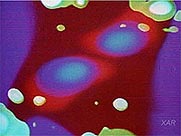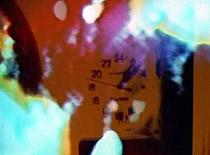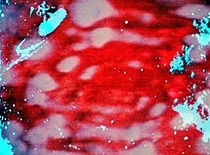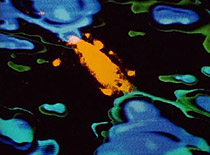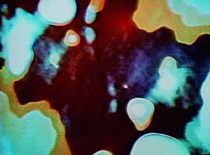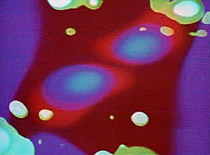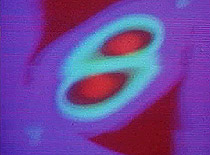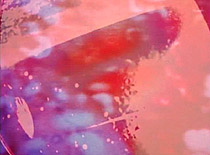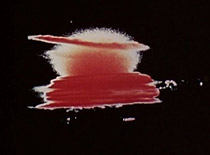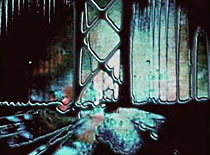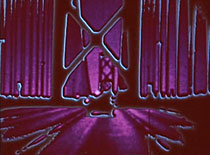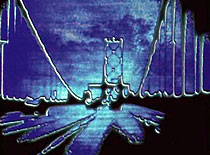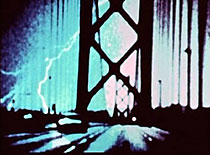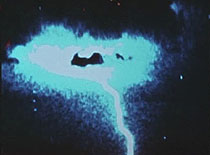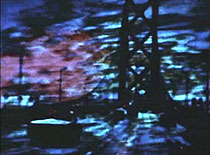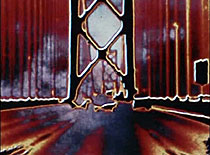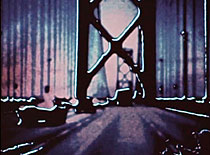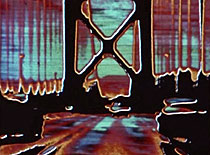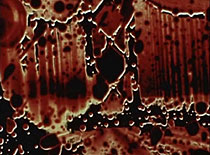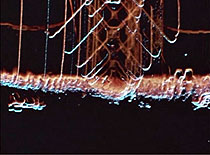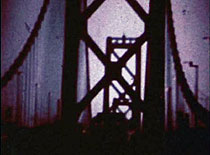|
SYNAESTHETIC AND EXPANDED CINEMA
EXPANDED CINEMA by GENE YOUNGBLOOD 1970 -- (R.I.P.) --
which describes the overall ambitions for this era
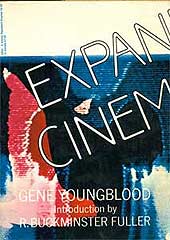
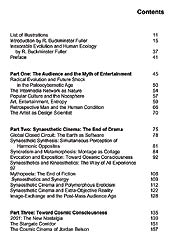
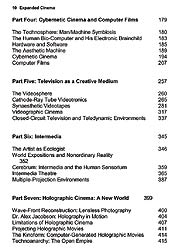
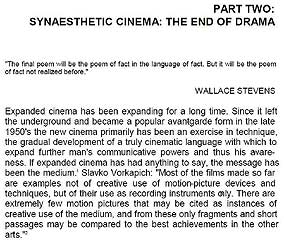
Download EXPANDED CINEMA by Gene Youngblood, 1970 (PDF)
Whereas Youngblood's Expanded Cinema describes 'synaesthetic cinema' as 'experimental cinema' primarily concerned with formalist issues and cinema-specific techniques, underground films did not end then (as a cinema or practice) but mutated into many forms.
Emergence of experimental film and video art:
'SYNAESTHETIC', 'BIO-FEEDBACK INTERACTIVE', 'INTER-MEDIA CINEMA'
and 'FILM - VIDEO HYBRIDS'
OFF ON by by Scott Bartlett
9 min. color sound 1967
A classic early example of creating a INTERMEDIA & HYBRID finished work
using film, using video, using loops and projection materials from light shows as inspiration
was OFFON by Scott Bartlett with assistance from Tom Dewitt, Manny Meyer, and Michael McNamee in 1967.
Watch Off On on YouTube at: https://www.youtube.com/watch?v=hEr9Z7Q4ZxY
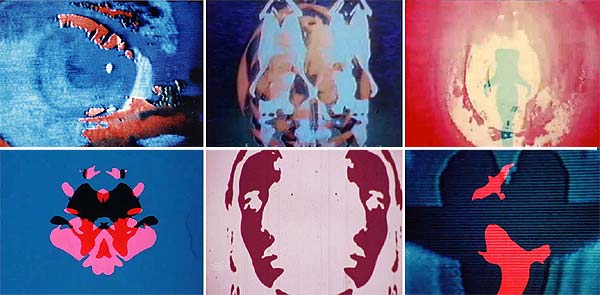
|
"OffOn is an experimental film created by Scott Bartlett made and released in 1968. It is most notable for being one of the first examples in which film and video technologies were combined. The nine-minute film combines a number of video loops which have been altered through re-photography or video colorization, and utilizes an electronic sound track to create its unique effect.
In 2004, the film was selected for preservation in the United States National Film Registry by the Library of Congress as being "culturally, historically, or aesthetically significant". " (Wikipedia)
On the relationship of Scott Bartlett's OFF ON with Pat O'Neill's 7362 film, both made in 1967:
"They are alike, and a comparison is warranted. I carried OffOn's answer print to an avant garde film show at UC Berkeley in 1967, not knowing "7362" was receiving its Bay Area premier showing. It was one of those rare moments of independent creativity that start new confluences in intellectual pursuits. Of course, I knew well enough what 7362 was, because it is how we were able to produce not only OffOn but the light shows that were edited into the OffOn. Did P O'N produce light shows?" - Tom DeWitt, contributor to OFFON film, 2004.
"Making Off On" by Cynthia Anne Haagens 1981 is at https://www.youtube.com/watch?v=yASi81-qxRI
Recent writings by Razutis: > Page on OFFON
7362 by Pat O'Neill
9 min. color sound 1967
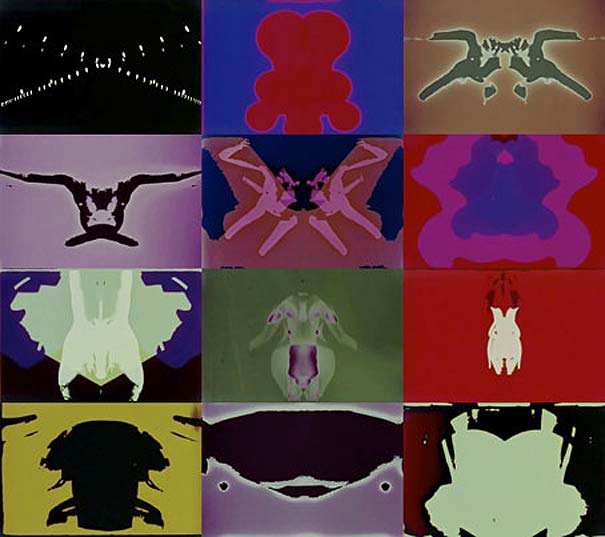
Frames from '7362' - panel by John Coulthart
Watch 7362 on YouTube at: https://www.youtube.com/watch?v=tRX5KWfqbkU
"Pat O'Neil...has made many experimental films using techniques perfected with an optical printer. This film incorporates footage of oil derricks in Venice, California and nude models filmed in the artist's studio. Its synthesizer score is by Joseph Byrd." -- Alessandro Cima.
"I finished my first film in 1962. Then I started doing abstract or composite films. I began to use the camera as a sort of gathering device to provide elements for manipulation through re-photography. This led to 7362 which was finished in 1967. I didn't have much knowledge about the history of the medium at that time. I had maybe three film classes at UCLA and beyond that the midnight screenings at the Coronet and the Cinema Theater were my education." -- Pat O'Neill, Millennium Film Journal interview 1997.
On the history of this
"My interests are to connect the dots... between light show projections, underground film, early video art, and what became called 'experimental cinema' and 'expanded cinema' as coined by Youngblood 1970." (Al Razutis)
Full thread on Scott Bartlett & Pat O'Neill films by Razutis
posted on FaceBook May 9, 2019
Additional:
2020 Commentary by Razutis on Face Book
> Top of Page
|
AAEON by Al Razutis
28 min. color sound 1969-71 - Al Razutis prod./dir
|
90 sec. excerpt video of 2 select sections AAEON
'head title', 'Nightwood'
from 16mm film sources on YouTube:
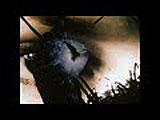
|
3 min. excerpt video from AAEON
'Nightwood' section
from 16mm film sources on YouTube:
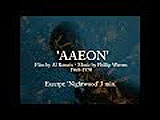
|
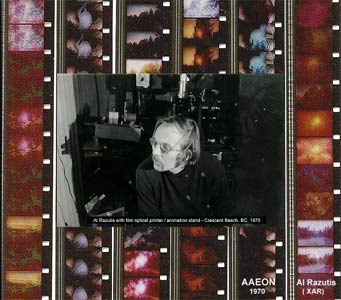
"AAEON is based on experiments with dream recollection - it is a 'dream work' inspired directly by my dreams and the recollection of the vivid imagery and fractured time that would be recalled nightly by purposely waking myself (every hour) and audio recording my recollections of the events. This project required the construction of a film 'machine', the film optical printer, which I built in various stages in 1969-1972 in Crescent Beach and Vancouver." Photo of early version of optical printer by Al Razutis.
"The film is composed of four interwoven stages or stanzas that constantly develop and redefine mythological space/time circulating around the ideas of 're-birth' (Tibetan Buddhist ideas, the Tarot, William Blake, oriental and western mysticism were some of the influences at the time) . The film is composed and edited on an optical printer effecting distortions of motion, time, composition, and colour through extensive use of 'layering' (in bi-pack printing, matte printing, step printing, colour separation, burning the film in a projection gate, infrared photography)." (A.R.)
Original music composed and performed by Phillip Werren. The music and imagery were created as a 'synergy' of both elements. Production assistance was also provided by Peter Jones, NFB Vancouver, one of the few individuals at the NFB who took an active interest in supporting underground and experimental films of the 60's-70's.
Appearing: Jurgen Hesse, Kathy Razutis, Ed Varney, and Al Razutis. Screened at the Bellevue Film Festival (1970).
In the collections of Pacific Cinematheque Pacifique, and National Film Board of Canada, Vancouver.
>> AAEON FILM PAGE - PICS / TEXTS
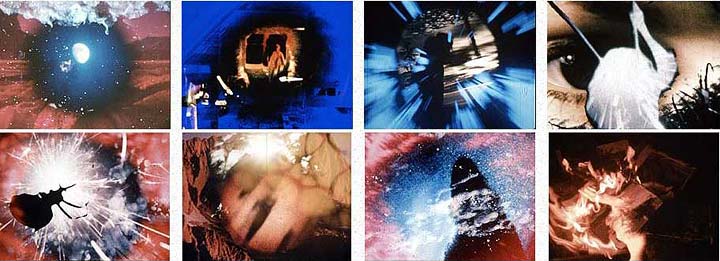
All remaining release prints of this film are now stored at the Academy
Archives in Hollywood, USA.
References:
Photo collage of AAEON frames and film optical printer / animation stand at Crescent Beach 1970, with Razutis making 'AAEON'.
Photo of final film optical printer at Visual Alchemy, Vancouver, 1974.
|
Synaesthetic Works - Film / Video Hybrids by Al Razutis
WATERCOLOR / ABSTRACT
3 min. color sound 1973 - Al Razutis prod./dir.
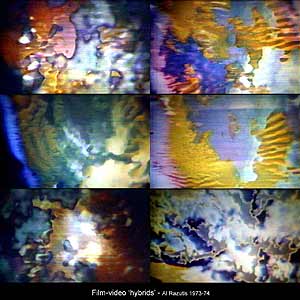
"'Watercolor/Abstract' was created in 1973 using both film and video processing as part of something I then called 'hybrids'. These hybrids, which also appeared in three film reels of my later film 'Amerika', featured combinations of film material, video processing (including colorization/keying and feedback, and bio-feedback), and optical printing. These seem to me a direct succession to underground films of the 60's (called 'Synaesthetic films' by Gene Youngblood in his book Expanded Cinema) by SF film-makers like Scott Bartlett, Tom Dewitt, and Jordan Belson (and others).
Additional experimetal works proceeding from these hybrids
were incorporated in film projected images that I did for
the Royal Winnipeg Ballet production of 'What To Do Until
the Messiah Comes', Vancouver 1975." (A.R.)
Originals film printing elements at the Academy Archives, Hollywood, USA
|
'Felix' Video
Synthesizer by Razutis & Armstrong -- Experimental Video studio technology 1970's
'Watercolor/Abstract' Hybrid Video Art essay by Al Razutis on FaceBook
|
12 min. color sound 1973 - Al Razutis prod./dir.
11 min.
ENTIRE FILM
on YouTube:
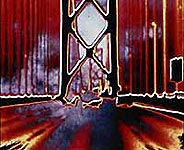
|
1 min.
30 sec. EXCERPT video
on YouTube:
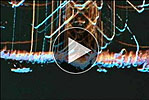
|
1 min.
40 sec. EXCERPT video
on YouTube:
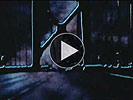
|
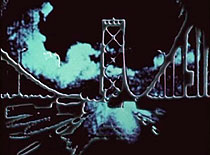
A repeating journey across the San Francisco Bay Bridge
becomes a journey into disintegrating visuals, video transformation,
with an accompanying sound track taken from "40 years of Radio".
As a film, it anticipated the end of the film medium, and the emergence
of the video medium.
The basis for this work is motion picture (photo-chemical) film subject to a transformation to electronic forms while engaged in chemical self-destruction.
Such synaesthetic and 'structural films broke new ground in
the experimental film 70's and the film-video 'hybrid' violated that
'special insularity' (the separation by media) that both film and video
artists of that time enjoyed.
As a single element of AMERIKA, 98.3 KHz:
( Bridge at Electrical Storm has garnered the most festival
awards and exposure.
Individually featured in international exhibitions,
retrospectives, including current 2020 exhibition at Artexte - Videographe 'Magnetic Sequences'.
Also a comprehensive analysis of this film and its place in media history was written by Essay by Bruce Jenkins
on Bridge at Electrical Storm for Magnetic
North Exhibition catalog
(jpeg images of successive pages - 200k per page)
In the
collection of Edith-Rus-Haus for Medienkunst, Oldenburg, Germany
In the collection of the National Gallery of Canada
Web page on VORTEX and 98.KHZ: (BRIDGE...
Film Optical Printer built by Razutis to create this film
Contemporary to much of this work cited here an archive or works by Al Razutis in underground, experimental film, experimental and hybrid video, in stereoscopic 3D film and video, which is found here: Razutis - Film and Video Archives
See also legacy Video
Synthesizer developed for these projects - photos
and historical photo page.
'Videographics: Selected Works' by Al Razutis (1972-1974)
('Software', 'Vortex', 'Aurora',
'Moon at Evernight', '98.3 KHz: Bridge at Electrical
Storm' - 40 min. )

1-2 min. excerpt videos from this work on YouTube:
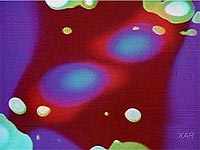
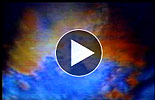
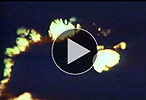

VIDEOGRAPHICS
is a collection of film - video 'hybrids' representing
the crossing over from film to video (back and forth)
image processing - synthesizing techniques that involved
both the video-synthesizer (Razutis - Armstrong
FELIX) and Razutis'
personally built film optical
printer. Neither exclusively 'film' nor 'video', these
groundbreaking works represented the first Canadian experimental
film-videos that challenged the oppressive critical orthodoxies
of (what is) 'film' or 'video' art that were rampant in
their respective 'scenes' at that time.
'Hybrid' by Al Razutis and Gary Lee-Nova (1973)
60 min. colour silent
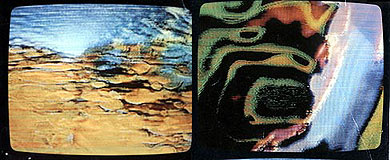
HYBRID is a video featuring some of the earliest experiments (done on 1" tape) in synaesthetic video art and 'hybrid' forms of film and video. It is an assemblage of 16mm film and video content that integrates both film (pre-existing film material by Razutis and Lee-Nova) and video intermediates which re-interpret this material using video synthetic processes (feedback, colorization, quantizing, abstracting). Razutis and Lee-Nova travelled to Evergreen State College, Olympia, Washington and Portland City College in Portland Oregon and engaged their supportive staffs to create this experimental video art piece over a number of months in 1972-1973.
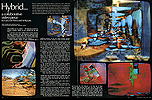
Arts Canada 1973 Video Issue - 'Hybrid' essay & graphics (large JPEG)
Higher resolution PDF file
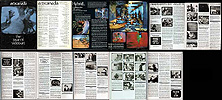
Arts Canada 1973 Video Issue - Full Section on Vancouver Video Art (large JPEG)
Higher resolution PDF FILE
In the collection of the Vancouver Art Gallery, Vancouver, Canada
'AURORA' by Al Razutis (1974)
sound, 6 min.
1-2 min. excerpt videos from this work on YouTube:


AURORA is a analog videosynthetic work incorporating film loops subject to colorization, quantizing and layering and was created by Razutis at the video facilities of Evergreen State
College (where he taught in 1972) and Vancouver (Visual
Alchemy) utilizing his 'Felix' video synthesizer.
'WAVEFORM' by Al Razutis (1974 - 1976)
'Waveform' and other
shorts - 26 min.

WAVEFORM documents
and interprets art created using bio-feedback experiments
conducted by Razutis and colleagues in Evergreen State
College (where he taught in 1972) and Vancouver (Visual
Alchemy). Artist was plugged into bio-monitoring devices
(Beckman EEG, ECG) which performed 'voltage controlled'
keying of looped film-video imagery in real-time synthesis.
The resulting 'loop' (artist - real-time display - artist)
became a 'feedback loop' which depended on artist's ability
to affect change (breathing, heartbeat, brainwaves) on
the synthesis process.
"Waveforms and Synapses" -- biofeedback and performance -- 4 min. on YouTube:
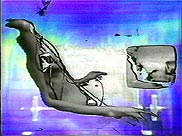
'SYNAPSE' by Al Razutis (1976)
Bio-feedback Performance
Video 60 min., 1976
Distribution Edit version with titles, 28 min., 1979
40 sec. excerpt video on YouTube:
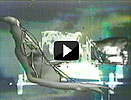

Before Virtual Reality (VR), before interactive digital graphics, there was bio-feedback and interaction with analog signals (video, audio, any waveform). And the 'medium' for this real-time interaction was the analog video-synthesizer, like the Felix, which was custom-built at Visual Alchemy by Jim Armstrong and Al Razutis.
SYNAPSE (live
broadcast bio-feedback performance piece on February 13, 1976, 8 p.m. Channel 10 Vancouver) is there to
remind us of what happens when artist plugs himself into
the bio-feedback machine in the 70's - artist as videosynthesizer, amplified by feedback loops, resulting in brain theta waves and accelerating and dangerous bio-rhythms.
'Film To Video / Video To Film' by Bruce Jenkins
Historical texts as reference:
'Recovering Lost History: Vancouver Avant-Garde Cinema 1960-1969' (Al Razutis)
Back to:
Psychedelic Cinema Underground History of Visual Alchemy Beyond Intermedia 1970's
Forward to:
Holographic Cinema of the 1970's
Drawing on Film - Video Archives
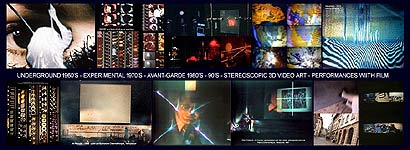
[HOME PAGE]
[PICTORIAL HISTORY OF VISUAL ALCHEMY]
[CURRENT PROJECTS - EXHIBITIONS - INFO]
[CRITICAL WRITINGS ON MEDIA]
| |











